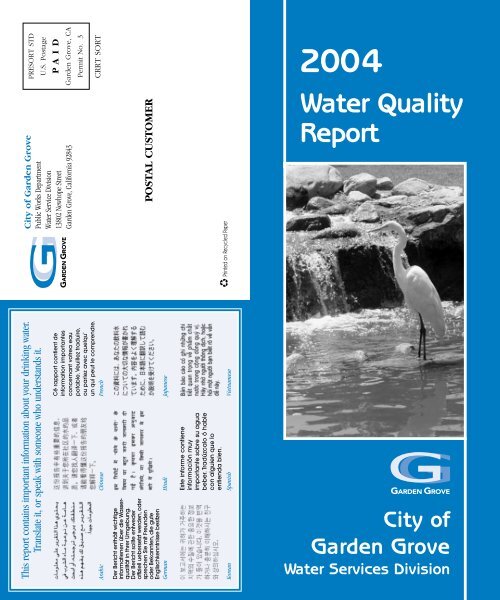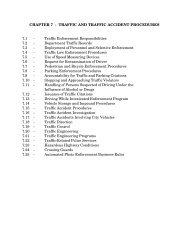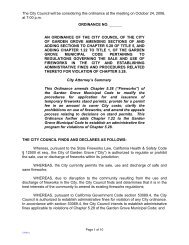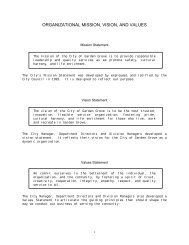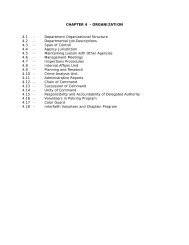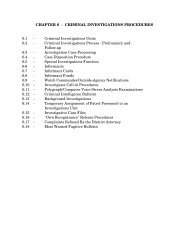Water Quality Report - Garden Grove
Water Quality Report - Garden Grove
Water Quality Report - Garden Grove
Create successful ePaper yourself
Turn your PDF publications into a flip-book with our unique Google optimized e-Paper software.
PRESORT STDU.S. PostagePA I D<strong>Garden</strong> <strong>Grove</strong>, CAPermit No. 3City of <strong>Garden</strong> <strong>Grove</strong>Public Works Department<strong>Water</strong> Service Division13802 Newhope Street<strong>Garden</strong> <strong>Grove</strong>, California 92843GARDEN GROVECRRT SORTPOSTAL CUSTOMERPrinted on Recycled Paper2004<strong>Water</strong> <strong>Quality</strong><strong>Report</strong>This report contains important information about your drinking water.Translate it, or speak with someone who understands it.Cé rapport contient deinformation importantesconcernant votrea eaupotable. Veuillez traduire,ou parlez avec quelqu’un qui peut le comprendre.Arabic Chinese FrenchDer Bericht enthält wichtigeinformatienen über die Wasserqualitätin threr Umgebung.Der Bericht sollte entwederoffiziell uebersetzt werden, odersprechen Sie mit Freundenoder Bekannten, die guteEnglischkenntnisse besitzenGerman Hindi JapaneseEste informe contieneinformación muyimportante sobre su aguabeber. Tradúzcalo ó hablecon alguien que loentienda bien.Korean Spanish VietnameseGARDEN GROVECity of<strong>Garden</strong> <strong>Grove</strong><strong>Water</strong> Services Division
The 2004 <strong>Water</strong> <strong>Quality</strong> <strong>Report</strong>Drinking <strong>Water</strong> <strong>Quality</strong>Since 1990, California water utilities have beenproviding an annual <strong>Water</strong> <strong>Quality</strong> <strong>Report</strong> to theircustomers. This year’s report covers calendar year2003 water quality testing, and has been prepared incompliance with new regulations called for in the1996 reauthorization of the Safe Drinking <strong>Water</strong> Act.The reauthorization charged the United StatesEnvironmental Protection Agency (EPA) withupdating and strengthening the tap water regulatoryprogram and changed the report’s due date to July 1.EPA and the California Department of HealthServices (DHS) are the agencies responsible forestablishing drinking water quality standards. Toensure that your tap water is safe to drink, EPA andDHS prescribe regulations that limit the amount of certain contaminants in water provided by publicwater systems. DHS regulations also establish limits for contaminants in bottled water that must providethe same protection for public health.If you have any questionsabout your water, pleasecontact us for answers…For information about this report, or your water qualityin general, please contact Zachary Barrett, <strong>Water</strong> <strong>Quality</strong>Supervisor, at (714) 741-5395. Public City Councilmeetings are held on the second and fourth Tuesdays ofeach month at 6:45 p.m. in the Council Chambers atthe Community Meeting Center, 11300 Stanford Avenue,<strong>Garden</strong> <strong>Grove</strong>, California. You may also contact our CityClerk’s Office, <strong>Garden</strong> <strong>Grove</strong> City Hall, 11222 Acacia Parkway,<strong>Garden</strong> <strong>Grove</strong>, CA 92840 or call (714 ) 741- 5040for information about <strong>Garden</strong> <strong>Grove</strong> City Councilmeetings. Please feel free to participate in these meetings.For more information about the health effects of the listedcontaminants in the following tables, call the EnvironmentalProtection Agency hotline at (800) 426-4791.Want Additional Information?There’s a wealth of information on the internetabout Drinking <strong>Water</strong> <strong>Quality</strong> and water issuesin general. Some good sites — both local andnational — to begin your own investigation are:Municipal <strong>Water</strong> District of Orange Countywww.mwdoc.comOrange County <strong>Water</strong> Districtwww.ocwd.orgMetropolitan <strong>Water</strong> Districtof Southern Californiawww.mwdh20.comCalifornia Department of Health Services,Division of Drinking <strong>Water</strong> andEnvironmental Managementwww.dhs.cahwnet.gov/ps/ddwemU.S. Environmental Protection Agencywww.epa.gov/safewater/The federal Food and Drug Administration(FDA) also sets regulations forbottled water.The City of <strong>Garden</strong> <strong>Grove</strong> vigilantlysafeguards its water supply and, as inyears past, the water delivered to yourhome meets the standards required bythe state and federal regulatory agencies.In some cases, your local utility goesbeyond what is required to monitor foradditional contaminants that haveknown health risks.Unregulated contaminant monitoringhelps EPA determine where certaincontaminants occur and whether it needsto establish regulations for thosecontaminants.
What You Need to Know,…and How it May Affect YouSources of SupplyYour drinking water is a blend of mostly groundwater from the OrangeCounty groundwater basin and also surface water imported by theMetropolitan <strong>Water</strong> District of Southern California. Metropolitan’simported water source is mostly the Colorado River, with augmentationby the State <strong>Water</strong> project from northern California. Your groundwatercomes from a natural underground reservoir managed by the OrangeCounty <strong>Water</strong> District that stretches from the Prado Dam and fansacross the northwestern portion of Orange County,excluding the communities of Brea and La Habra, andstretching as far south as the El Toro ‘Y’.Last year, as in years past, your tap water met all EPAand State drinking water health standards. The City of<strong>Garden</strong> <strong>Grove</strong> vigilantly safeguards its water suppliesand once again we are proud to report that our systemhas never violated a maximum contaminant level orany other water quality standard. This brochure is asnapshot of last year’s water quality. Included aredetails about where your water comes from, what itcontains, and how it compares to State standards. Weare committed to providing you with informationbecause informed customers are our best allies.The City’s source water comes from 12 groundwaterwells. Imported water comes from the Sierra Nevadaand the Colorado River area.Basic Information AboutDrinking <strong>Water</strong> ContaminantsDrinking water, including bottled water, may bereasonably expected to contain at least small amountsof some contaminants. As water travels over the surfaceof the land or through the layers of the ground itdissolves naturally occurring minerals and, in somecases, radioactive material, and can pick up substancesresulting from the presence of human or animalactivity. For most people, the presence of contaminantsdoes not necessarily mean water may be a health risk.Contaminants that may be present in source water include:✦ Microbial contaminants, such as viruses and bacteria, which maycome from sewage treatment plants, septic systems, agriculturallivestock operations and wildlife.✦ Inorganic contaminants, such as salts and metals, which can benaturally occurring or result from urban storm runoff, industrialor domestic wastewater discharges, oil and gas production,mining and farming.Where Your <strong>Water</strong> Comes FromReservoirMetropolitan <strong>Water</strong> Districtof Southern California(MWD of Orange County)<strong>Water</strong>TreatmentPlantStorageTankState<strong>Water</strong> Project(Northern California)Well<strong>Water</strong>DisinfectionFacilityColoradoRiverUnderground Aquifer(Groundwater)PercolationPondSanta AnaRiverOrange County<strong>Water</strong> DistrictGroundwaterRechargeIllustration by Victor Casados<strong>Water</strong> Distribution System: Imported water supplied by Metropolitan <strong>Water</strong> District of Southern California (via MWD ofOrange County) and piped to your community by your local water retailer. Your groundwater is managed by theOrange County <strong>Water</strong> District and pumped out of the ground by your local water retailer.
What You Need to Know,…and How it May Affect YouSources of SupplyYour drinking water is a blend of mostly groundwater from the OrangeCounty groundwater basin and also surface water imported by theMetropolitan <strong>Water</strong> District of Southern California. Metropolitan’simported water source is mostly the Colorado River, with augmentationby the State <strong>Water</strong> project from northern California. Your groundwatercomes from a natural underground reservoir managed by the OrangeCounty <strong>Water</strong> District that stretches from the Prado Dam and fansacross the northwestern portion of Orange County,excluding the communities of Brea and La Habra, andstretching as far south as the El Toro ‘Y’.Last year, as in years past, your tap water met all EPAand State drinking water health standards. The City of<strong>Garden</strong> <strong>Grove</strong> vigilantly safeguards its water suppliesand once again we are proud to report that our systemhas never violated a maximum contaminant level orany other water quality standard. This brochure is asnapshot of last year’s water quality. Included aredetails about where your water comes from, what itcontains, and how it compares to State standards. Weare committed to providing you with informationbecause informed customers are our best allies.The City’s source water comes from 12 groundwaterwells. Imported water comes from the Sierra Nevadaand the Colorado River area.Basic Information AboutDrinking <strong>Water</strong> ContaminantsDrinking water, including bottled water, may bereasonably expected to contain at least small amountsof some contaminants. As water travels over the surfaceof the land or through the layers of the ground itdissolves naturally occurring minerals and, in somecases, radioactive material, and can pick up substancesresulting from the presence of human or animalactivity. For most people, the presence of contaminantsdoes not necessarily mean water may be a health risk.Contaminants that may be present in source water include:✦ Microbial contaminants, such as viruses and bacteria, which maycome from sewage treatment plants, septic systems, agriculturallivestock operations and wildlife.✦ Inorganic contaminants, such as salts and metals, which can benaturally occurring or result from urban storm runoff, industrialor domestic wastewater discharges, oil and gas production,mining and farming.Where Your <strong>Water</strong> Comes FromReservoirMetropolitan <strong>Water</strong> Districtof Southern California(MWD of Orange County)<strong>Water</strong>TreatmentPlantStorageTankState<strong>Water</strong> Project(Northern California)Well<strong>Water</strong>DisinfectionFacilityColoradoRiverUnderground Aquifer(Groundwater)PercolationPondSanta AnaRiverOrange County<strong>Water</strong> DistrictGroundwaterRechargeIllustration by Victor Casados<strong>Water</strong> Distribution System: Imported water supplied by Metropolitan <strong>Water</strong> District of Southern California (via MWD ofOrange County) and piped to your community by your local water retailer. Your groundwater is managed by theOrange County <strong>Water</strong> District and pumped out of the ground by your local water retailer.
✦ Radioactive contaminants, which can benaturally occurring or be the result of oil andgas production or mining activities.✦ Pesticides and herbicides, which may comefrom a variety of sources such as agriculture,urban storm water runoff, and residentialuses.✦ Organic chemical contaminants, includingsynthetic and volatile organic chemicals,which are by-products of industrial processesand petroleum production, and can also comefrom gasoline stations, urban storm waterrunoff and septic systems.CryptosporidiumCryptosporidium is a microscopic organismthat, when ingested, can cause diarrhea, fever, and other gastrointestinalsymptoms. The organism comes from animal and/orhuman wastes and may be in surface water. The Metropolitan <strong>Water</strong>District of Southern California, which did not detect it in the water,tested your surface water for Cryptosporidium in 2003. If it ever isdetected, Cryptosporidium is eliminated by an effective treatmentcombination including sedimentation, filtration and disinfection.The EPA and the federal Centers for Disease Control guidelines onappropriate means to lessen the risk of infection byCryptosporidium and other microbial contaminants are availablefrom EPA’s safe drinking water hotline at (800) 426-4791 between9 a.m. and 5 p.m. Eastern Time (6 a.m. to 2 p.m. in California).Immuno-compromised peopleSome people may be more vulnerable to constituents in the waterthan the general population.Immuno-compromised people, such as those with cancer who are undergoingchemotherapy, persons who have had organ transplants, peoplewith HIV/AIDS or other immune system disorders, some elderly personsand infants can be particularly at risk of infections. These people shouldseek advice about drinking water from their healthcare providers.NitrateThe maximum allowable level of nitrate in drinking water, alsocalled the maximum contaminant level or MCL, is 45 milligramsper liter as nitrate (mg/L as NO 3 ). The nitrate MCL can also beexpressed as 10 milligrams per liter as nitrogen (mg/L as N). Bothnumbers are equivalent values. At times, nitrate in your tap watermay have exceeded one-half the MCL, but it was never greater thanthe MCL. The following advisory is issued because in 2003 werecorded nitrate measurements in the drinking water supply whichexceeded one-half the nitrate MCL.Nitrate in drinking water at levelsabove 45 mg/L (or the equivalent10 mg/L as N) is a health risk forinfants of less than six months of age.Such nitrate levels in drinking watercan interfere with the capacity of theinfant’s blood to carry oxygen,resulting in a serious illness;symptoms include shortness of breathand blueness of the skin. Nitratelevels above 45 parts-per-million mayalso affect the ability of the blood tocarry oxygen in other individuals,such as pregnant women and thosewith certain specific enzymedeficiencies. If you are caring for aninfant, or you are pregnant, youshould ask advice from your health care provider.The City of <strong>Garden</strong> <strong>Grove</strong> lowers the nitrate concentration of its waterby blending its well waters. At no time did the drinking water exceedthe MCLs for nitrate.Import (Metropolitan) <strong>Water</strong> AssessmentIn December 2002, Metropolitan <strong>Water</strong> District of SouthernCalifornia completed its source water assessment of its ColoradoRiver and State <strong>Water</strong> Project supplies. Colorado River supplies areconsidered to be most vulnerable to recreation, urban/storm waterrunoff, increasing urbanization in the watershed and wastewater.State <strong>Water</strong> Project supplies are considered to be most vulnerableto urban/storm water runoff, wildlife, agriculture, recreation andwastewater. A copy of the assessment can be obtained by contactingMetropolitan by phone at (213) 217-6850.Groundwater AssessmentAn assessment of the drinking water sources for City of <strong>Garden</strong><strong>Grove</strong> <strong>Water</strong> Services Division was completed in December 2002. Thegroundwater sources are considered most vulnerable to the followingactivities associated with contaminants detected in the water supply:Known contaminant plumes, historic agricultural activities andapplication of fertilizers, and parks. The groundwater sources areconsidered most vulnerable to the following activities not associatedwith detected contaminants: Confirmed leaking underground storagetanks, dry cleaners, gas stations, and photo processing/printing.A copy of the complete assessment is available at Department ofHealth Services Office of Drinking <strong>Water</strong>, Santa Ana District,28 Civic Center Plaza Room 325, Santa Ana, CA 92701. You mayrequest a summary of the assessment by contacting the City of<strong>Garden</strong> <strong>Grove</strong> <strong>Water</strong> Services Division at (714) 741-5395.
City of <strong>Garden</strong> <strong>Grove</strong> Groundwater <strong>Quality</strong>PHG Average Range of MCL Most Recent Typical SourceChemical MCL (MCLG) Amount Detections Violation? Sampling Date of ContaminantRadiologicalsAlpha Radiation (pCi/L) 15 n/a 9.4 4.1 – 13 No 2003 Erosion of Natural DepositsUranium (pCi/L) 20 0.5 9.3 3.5 – 15 No 2003 Erosion of Natural DepositsOrganic Chemicals1,1,1 – Trichloroethane (ppb) 6 10
Metropolitan <strong>Water</strong> District of Southern California Treated Surface <strong>Water</strong>PHG, or Average Range of MCLChemical MCL (MCLG) Amount Detections Violation? Typical Source of ContaminantRadiologicals – Tested in 2003Alpha Radiation (pCi/L) 15 n/a


